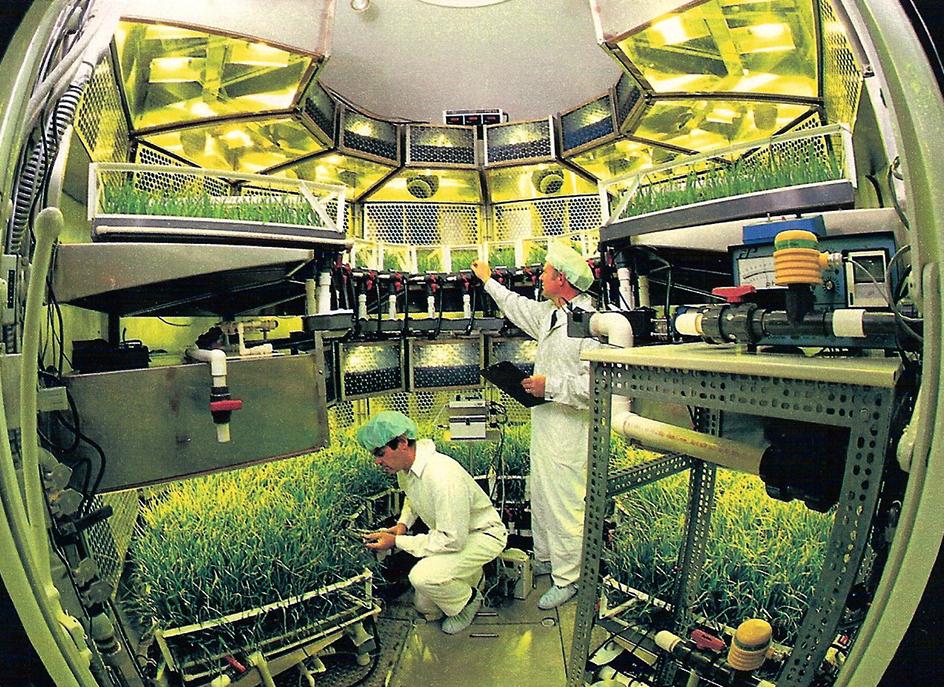
NASA Research Launches a New Generation of Indoor Farming
Subheadline
The first vertical farm in the U.S. provided a foundation for expanding the controlled environment agriculture industry
The United Nations predicts Earth will have to feed another 2.3 billion people by the year 2050, with most concentrated in urban centers far from farmland. Current agriculture may not have the capacity to feed that many people, and it could threaten future production by depleting soil of essential nutrients and contaminating freshwater supplies and soil with pesticides and herbicides.
Conventional farmers are working to make their fields more efficient and productive and less harmful to the environment – at times with innovations and other support from NASA – but these changes are only part of a long-term solution.
NASA has been working for decades to tackle similar problems for space exploration. Reusing a limited water supply, minimizing energy consumption, and eliminating soil as a growth medium are just a few ways the agency stretches the limited resources available in space. Research into solving these challenges to grow plants in a closed environment like a spacecraft inspired NASA to build the first vertical farm in the United States, creating a foundation for the controlled environment agriculture industry to build on. The lessons learned are inspiring an unconventional new generation of farmers.
Called controlled environment agriculture or CEA, this combination of plant science and environmental control techniques optimizes plant growth inside an enclosed space. Unlike a traditional greenhouse, this new vertical approach to cultivation leverages technology and data to maintain ideal growing conditions in a completely closed structure. These tools make it possible to filter contaminants from water for crops (keeping them out of food) and deliver the exact nutrient balance to feed any crop throughout its life cycle. Artificial lighting can eliminate the effects of fluctuating solar light, nurturing growth with a precise mix of beneficial red, blue, and green light at the right intensity and duration. Environmental controls also maintain proper temperature and humidity to prevent disease.
These practices could help feed Earth’s burgeoning future generations, said Nate Storey, chief science officer at Plenty Unlimited Inc., one of several companies building on NASA plant-growth research with an eye toward bringing agriculture into the urban environment.
Plenty’s farming model uses less than 1% of the water required by traditional farming and yields a consistent harvest year-round, regardless of weather. Built inside cities, this growing environment is also completely contained, eliminating the threat of drought or pest invasion. Indoor and vertical, these farms grow more crops in a much smaller area. The two-acre Plenty farm produces approximately the same yields as a 720-acre outdoor farm.
The approach produces fresher, healthier, more flavorful plants.
After decades of NASA research, the CEA industry expanded dramatically in the 1990s due in part to hundreds of millions of dollars invested by high-tech companies. Currently some estimates value the global market worth about $2.9 billion, the vertical farming market is projected to reach $7.3 billion by 2025.
“The entire industry is built on NASA research,” said Storey, noting that NASA publications and NASA-funded studies by universities proved that controlled environment farming was possible and laid the foundation for a viable commercial industry.
Space-Inspired Farming
From the start, NASA knew it needed to provide astronauts with food in addition to building their living environment. Combining the two requirements resulted in a bioregenerative life-support system. Plants would recycle waste into resources, produce breathable oxygen, and remove CO2 from the air, all while providing fresh food to supplement prepared meals.
The earliest experiments used algae, but turning that plant material into palatable food was too complicated, recalled Ray Wheeler, plant physiologist at NASA’s Kennedy Space Center in Florida. So the Closed Ecological Life Support System (CELSS) program began funding research with universities to identify the best plants for space and their ideal growth conditions.
Meanwhile, the agency built a prototype growth chamber to replicate and expand on the university findings. NASA needed to scale up those small experiments to confirm edible crops could adequately support an astronaut before depending on such a system, explained Wheeler.
“Growing plants or crops is a multi-functional life-support approach,” he said. “But we needed to answer the question, can you do this in a closed environment like you have in space?”
As the lead for Advanced Life Support Research, Wheeler helped conduct growth experiments in the Biomass Production Chamber, built in the late 1980s inside a decommissioned hypobaric chamber left over from testing the Mercury space capsule. The chamber interior was modified to create the country’s first fully operational vertical farm.
“The system recycled and reused as much as possible – water, air, nutrients – making it self-contained, just as it will have to be in space or on another planet," said Wheeler.
Adjustable shelving created vertically stacked levels of hydroponic trays, with just enough water and nutrients flowing through them. Between each shelf, a bank of high-intensity discharge lamps simulated sunlight. Air circulated across the plant canopy and vented back through the lights, making it possible to remove excess heat, control the humidity, and help maintain and measure other environmental conditions.
Dozens of plant experiments were conducted during the chamber’s nearly nonstop operation between 1988 and 2000, producing a “firehose of data.” Wheeler said the team measured multiple data points, including biomass yields, CO2 removal, oxygen production, and more. Growth recipes (optimal conditions for a plant species) and other data were made publicly available in databases and hundreds of technical reports and peer-reviewed papers. NASA-funded university studies shared still more results.
From that body of work, Storey learned the techniques and benefits of a closed-loop system. He said Plenty adopted the “nutrient film technique” that NASA employed, growing plants without soil and with minimal water. This hydroponic system houses seedlings in shallow channels, circulating a constant film of water that contains all the nutrients the plants require. The roots form a thick mat in the channel, allowing them access to both the air and water they need.
But the San Francisco-based company houses this system in its own vertical infrastructure. Tall, dual-sided towers hang from the ceiling in rows with water flowing from top to bottom. The water is then collected and filtered, and its nutrients are replenished before it’s recirculated. When the seedlings begin to grow, the result is a wall of greens – a large, vertical canopy.
“We learned that a large growing surface improved uniformity and plant performance – it was healthier for the plants and easier to maintain,” said Storey. “Humidity and temperature management at the canopy is more uniform, which is important to support stress-free growth."
By controlling every element of the environment, Plenty doesn’t need to use harmful chemicals such as pesticides and herbicides. But the company is continually researching ways to improve crop conditions.
Plant-Growth R&D
Different plants require different balances of water, nutrients, light, airflow, and more. NASA studied and documented all this information for dozens of species, and now Green Sense Farms Holdings Inc. is using some of that individualized plant research to help growers on Earth.
Having gleaned important farm-design and plant-growth recipe information from NASA-sponsored research, the company offers contract R&D services for plant-growth optimization, which is handled in its climate-controlled vertical farm in Portage, Indiana. The facility uses proprietary software to adjust conditions and collect plant-growth data. This precise control and measurement make it possible not only to optimize every variable that impacts a plant but also to select plant varieties, known as cultivars, that maintain a particular set of characteristics under specific conditions.
“We’ll look at all of the variables and stressors, trying many different approaches until we optimize the growth of that cultivar in a controlled environment setting,” said Robert Colangelo, Green Sense president. One example is testing the ratio of red to blue in LED grow lights, their intensity, and how long they shine in a day.
This approach, based on NASA research, means using only the portion of the light spectrum a plant needs – which also reduces electricity consumption (Spinoff 2010, 2018, 2019). And using a closed-loop nutrient recycling system allows for water and nutrient conservation to grow crops sustainably.
Green Sense also developed a technique to suspend the growth of hemp plants to accommodate problems caused by inclement weather on outdoor farms. A set of specific conditions keeps the plants alive and healthy without growing until the weather allows for replanting.
The agency provided the starting point for this research into the specific needs of plant types and tailoring operations to efficiently meet those needs, Colangelo explained.
“You have to conserve everything when you’re in space,” he said. “So when we built our systems, we built with that in mind. We looked at everything and designed it to have ultimate efficiency to conserve energy.”
Redefining ‘Data Farm’
Developing these sophisticated growth systems requires data to validate and tweak ideal conditions and catch problems early. What is measured and how is essential to Bowery Farming Inc.’s vertical farms, said Henry Sztul, chief science officer.
The New York City-based company custom-builds urban vertical farms inside existing structures such as vacant warehouses and distributes produce locally to restaurants and grocery stores.
Environmental sensors and cameras throughout the facilities constantly monitor crops and the environment. The company’s proprietary system, dubbed the Bowery OS, makes use of machine learning and artificial intelligence to make sense of that data and manage any crop growth cycle.
Just as a person can learn to identify tip burn on a leaf of butter lettuce, computers can be taught the same kind of recognition. Using thousands of pictures taken throughout a farm, computers learn to identify problems and adjust any part of the system, said Sztul.
Scaling up NASA’s data-driven vertical growth model to support commercial production required the company to innovate. But NASA has provided additional expertise in an unexpected way – trained staff. Some of Bowery’s employees worked on a NASA-funded effort to test plant growth in a simulated space habitat in Antarctica. As students, these employees gained practical experience while demonstrating a remotely controlled closed-loop plant-growth chamber. Several others who worked in NASA’s farm at the South Pole Station have also brought that experience to bear in the industry, including the chief engineer at Green Sense Farms.
With three farms in production, Bowery plans to expand to more locations and diversify its crops. But the company is also looking to breed more varieties of current crops that will thrive in a controlled environment. The ability to fine-tune the environment can speed up this breeding program from 10 years to just two or three, explained Sztul.
Specialized Spuds
Vertical farms aren’t the only part of the CEA industry benefiting from NASA growing successes. Potato farmers are now using nutrient film technique to grow seed potatoes in greenhouses. The agency pioneered this hydroponic method to grow root zone crops like potatoes, sweet potatoes, and peanuts, according to Wheeler.
Astronauts won’t have the luxury of soil, so NASA developed recipes for hydroponically growing some of these staple crops. This wildly successful technique proved itself with a record-breaking potato yield.
The world record for potato yield is approximately 89,000 pounds per acre. A NASA-funded test in a controlled environment facility at the Wisconsin Biotron Laboratory produced an equivalent of 175,000 pounds per acre, nearly twice the best field-grown yields.
CSS Farms LLC uses the same hydroponic nutrient film practice in its greenhouses to grow seed potatoes, also called minitubers, for customers. The year-round harvesting operation uses many of the same techniques as closed-loop vertical farms – hydroponic growth systems and carefully monitored nutrients customized to the plant variety – but in a less tightly controlled environment that relies on fresh air and sunlight.
Unlike plants grown from seed, such as corn or wheat, potatoes are grown from “seed potatoes” – either cut potato tubers or minitubers that can be grown using hydroponics in greenhouses. These minitubers can easily be shipped and then planted in field settings, where they grow into potato plants that produce large tubers for consumption or processing (Spinoff 2000).
Using NASA’s techniques, CSS, now a Colorado Certified Seed Potato Grower, gets impressive yields.
Conventional growing methods using a potting soil mix typically yield five or six minitubers per plant. “We’ll harvest two or three times a week for about a 12-week harvest period in three crops per year. In a nutrient film system, you can get anywhere between 30 and 50 minitubers per plant,” said Matt Barrow, greenhouse general manager at the company, which is headquartered in Watertown, South Dakota, but has operations across about 10 states.
Eating Like Astronauts
Long-duration space explorers will benefit from this kind of fresh produce, whether during an extended stay on the Moon or a three-year round trip to Mars. The same is true for people on Earth, where climate change and population growth already cause food insecurity for many communities.
“We need to get much smarter as a society to determine what crops should be grown outdoors and which should be grown indoors,” said Colangelo. He likened the use of vertical farming to a supplemental approach to field farming, just as greenhouses have become an integral tool for the world’s food supply.
The industry is growing, but progress is slow. Unlike conventional farms, controlled environment agriculture operations don’t receive federal subsidies. So individual businesses rely on private investment and sales to grow and become profitable.
Leafy greens that grow quickly and are in high demand, such as lettuce, kale, and spinach, are now the staple crops. As more fruits and vegetables are added and profits increase, the industry can continue to expand.
Until then, the U.S. Department of Agriculture (USDA) “has no specific regulation regarding controlled environment agriculture yet,” said Tianbao Yang, of the department’s Agriculture Research Service (ARS), adding that the fledgling industry’s self-imposed tight controls have prevented safety from becoming a major issue.
However, the USDA-ARS has organized a committee to help plant scientists understand how to effectively and consistently use controlled environment technology.
This resource, accessible to both private industry and educational institutions, also includes the growing expertise developed at the space agency.
“NASA researchers have made a great deal of contributions on optimizing plant growth under controlled environments,” Yang said. “For example, my research has benefited from their research on light effects on vegetable growth and plant response to stresses.”
As NASA continues to make advances through experiments on the space station and in ground facilities to develop an astronaut life-support system, these innovations will continue to support the growth of the controlled environment agriculture industry.
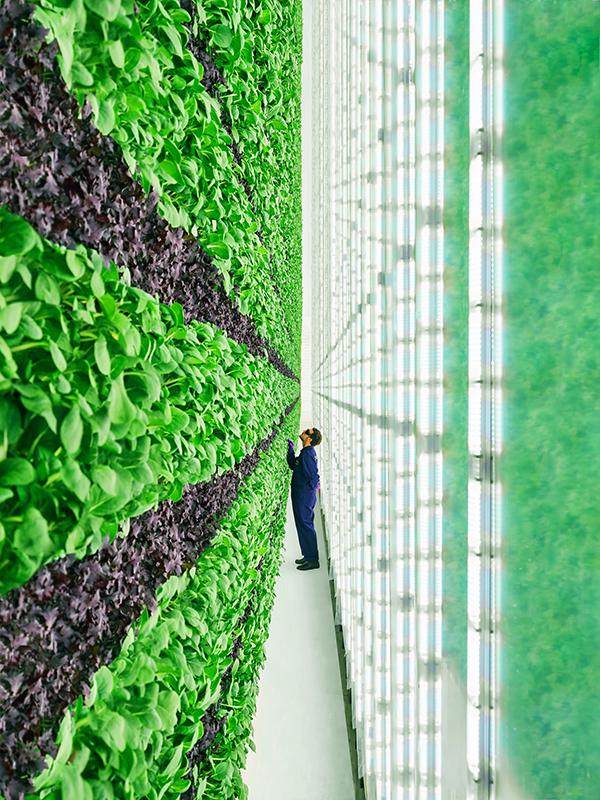
One way Plenty Unlimited maintains plant health is by using robotics in nearly every step of the farming process. Proprietary technology grows the company’s Spicy Mizuna Mix, shown here, and relies on data to optimize growing conditions. The growing environment mimics the closed-loop environment developed by NASA in the Biomass Production Chamber that demonstrated how to grow plants without sunlight and open air. Credit: Plenty Unlimited Inc.
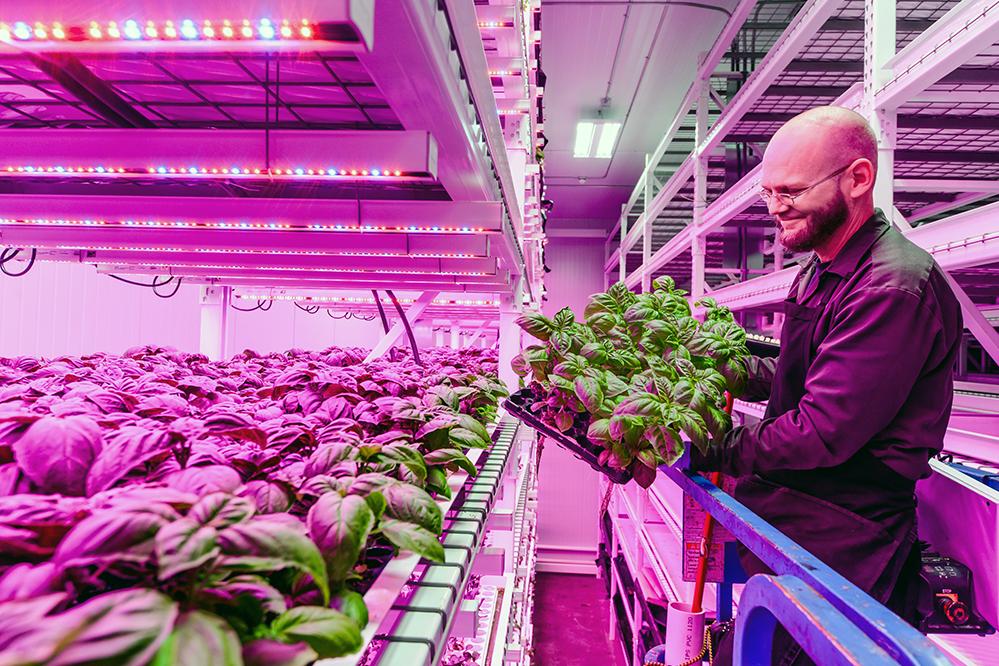
Green Sense uses LED lights in its vertical farms, adjusting the mix of red and blue light for each plant species. Lane Patterson, chief engineer, examines the successful cultivation of Italian basil. Patterson gained valuable experience in indoor farming when he worked at the South Pole Station, operating an indoor growth chamber that was partly funded by NASA. Credit: Green Sense Farms Holding Inc.
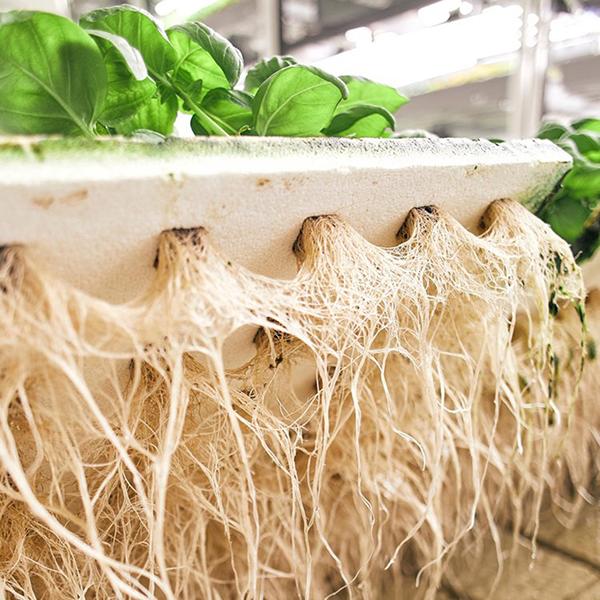
Plants grown by Bowery Farming using nutrient film technique, a vertical hydroponic system pioneered by NASA, develop a dense root mat that absorbs water, nutrients, and oxygen without using soil. A thin film of water continually flows through the tray underneath the roots, using 2-5% of the water required by plants grown outdoors. Credit: Bowery Farming Inc.
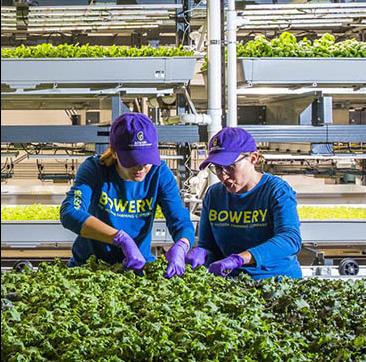
Inside abandoned city buildings, Bowery Farming builds vertical farms that provide fresh produce to local retailers and restaurants. The closed system produces food all year, eliminating the problems that limit outdoor farming such as drought, winter temperatures, and bug infestations. Credit: Bowery Farming Inc.

The fruit and greenery of potato plants are poisonous to humans, but the tubers that grow on the roots are a staple crop around the world. CSS Farms cultivates minitubers that will later be used in field farming to grow the potatoes we buy in grocery stores. Credit: CSS Farms LLC

The interior of the Biomass Production Chamber at Kennedy Space Center replicated the closed growing environment astronauts will use in space or on other planets to grow fresh crops. As the first controlled environment vertical farm in the United States, the chamber helped NASA provide critical data for the indoor farming industry. Credit: NASA













